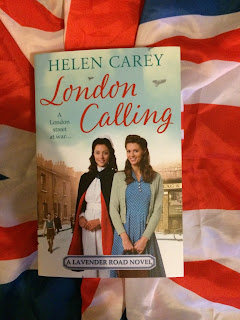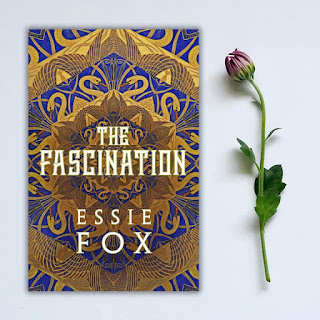I am delighted to be part of the London Calling Christmas Blog Tour to celebrate its publication on December 15th 2016.
LONDON CALLING is an irresistible, romantic and nostalgic novel about a resilient community of friends and neighbours in Clapham, South London, during the Second World War.
I am so pleased to welcome its author, Helen Carey to Books, Life and Everything with her guest author post on Cooking in Wartime Britain.
Helen:
Cooking with wartime ingredients - fancy a chitterling anyone?
One of the delights of writing is doing the research, so, for someone like me who loves food, what could be better than introducing a character into my latest novel who is interested in cooking and runs a café? Well actually quite a lot. Because it has to be said that the period of the Second World War in London does not go down as the most inspiring period of cuisine in history.
At the start of the Second World War in 1939, the UK imported 70% of its cheese and sugar requirements, 80% of fruit, 70% of cereal and fat, and 50% of meat. With Nazi U-boats attacking all incoming merchant shipping, supplies from overseas quickly disappeared from the shelves, leaving people with very limited, or no, access to (in my view) essential ingredients such as onions, garlic, spices or sugar.
To ensure that what remained was fairly distributed, rationing was introduced, and all of this meant that the scope for culinary creativity was considerably curtailed. It also meant that more easily obtainable (but considerably less appetising) foodstuffs began appearing on the agenda.
Whale meat, for example, was not greeted with very much enthusiasm. And I, for one, would not have been thrilled to find chitterlings (pigs’ intestines) on the menu at the local café, let alone boiled snout, crispy pigs tail, or jellied trotters. Poor old pigs. Indeed, one lady, whose diary I read, remarked that ‘where pigs are concerned, all but the squeak is being eaten these days’.
The Ministry of Food did their best, but some of their suggested recipes don’t fill me with glee either. I think I could have just about coped with a sausage pancake or curried carrots, but I’m not sure about vinegar cake, fish and cabbage spread sandwiches or pilchard soup with ‘suet-less dumpling floaters’.
Foraging has become fashionable nowadays, but then it was the only way to ‘lift a dish’. My wartime café manager, Joyce Carter, found that nettle tips (which don’t sting once cooked), dandelions, wild garlic leaves, daisy flowers, blackberries, sloes, rosehips, hazelnuts, clover and sorrel all added a little ‘je ne sais quoi’ to the everyday routine of rationed meat and two (meagre) veg.
So while you tuck into your Christmas dinner this year, spare a thought for all those millions of people who lived through six long years of enforced culinary frugality.
And just in case you’d like to make a wartime ‘Christmas treat’ for yourself, I leave you with Mrs Carter’s recipe for Fruit Leather.
Fruit Leather
Cut up 2lb apples, crab apples, pears, rose hips or blackberries (or mixture)
Gently cook fruit in a saucepan with a little water until very soft
Preheat oven 210 F
Line two metal trays with parchment (or non stick liner)
Push fruit through a sieve to remove pith
Add honey or sweetener to taste
Smooth mixture over the two trays, cover with more parchment and cook for 12 hours (ideally transfer into a hay box after a few hours for economy) until leather is completely dry.
Once cooked, change the parchment and roll up tightly to store. Can be kept for six months in airtight jar. Cut slices as required. Yum!
Marianne: Thanks, Helen, that's fascinating reading. Wartime recipes always make me smile as my Mum had a 'delicious' wartime recipe for a rubbed in sponge cake which she used to use well into the 1970's ... mmm.
LONDON CALLING is the fourth in the Lavender Road series.
It will take more than Hitler's Luftwaffe to break the spirit and resilience of the residents of Lavender Road. If courage and resilience could win wars, the conflict would be already over.
It's not all harmony though. Nurse Molly Coogan and would-be actress Jen Carter certainly don't see eye to eye. Molly, despite hating the discipline of wartime hospital life, is unimpressed by Jen's prima donna ways. Jen, unaware of Molly's secret heartache, can't resist taking her own frustrations out on Molly. It's just as well that no one knows what challenges lie ahead.
From stolen glasses in the Flag and Garter to fancy dinners in the heart of the West End, from a desperate battle for survival on a hospital ward to a torpedo hitting its target in the Mediterranean Sea, LONDON CALLING takes readers into a world of ordinary people living extraordinary lives.
My Thoughts
LONDON CALLING captures the atmosphere of life in London in the Second World War. From details about food and everyday life, to news of the war itself, it marries together the personal and the national aspects of life in that era. Separation from loved ones and the restrictions of life in the 1940's makes you see that no one has an easy life but it is a close community. The characters draw you in and you find yourself caring about what happens to them.
This is the fourth book in the Lavender Road series but it can be read as a standalone. Starting in 1942, life is tough for the residents. As you follow each character's story, it is easy to empathise with them, especially with the undervalued Mollie who finds it difficult to work within the restricting hierarchy of the hospital. I also enjoyed Jen who dreams of being on the stage. Loyalty to friends knits the community together as well as a drive to 'keep on carrying on'. Joyce, a middle aged lady who works in the local cafe typified this 'make do and mend' mindset of the era, when she stretches the rations and produces delicious meals.
I found this book to be easy to read despite its length. There was plenty to keep the interest and the background of one London Street and its inhabitants was beautifully drawn as we follow where in the world life takes them.
In short: A book packed full of relatable characters and historical realism.
About the Author
Helen Carey was born in Oxford and lived in London for many years. Before she began writing she had a range of jobs, including tour guide, army officer amd management consultant. Her Lavender Road novels were inspired by a chance encounter with a neighbour who showed her the sites of the air-raid shelters on Clapham Common. She now lives with her husband and their two dogs in Wales.
You can find Helen on Twitter , on her Website and on Facebook
Thanks to Katie Bradburn at Headline Press for a copy of the book and a place on the Blog Tour.
Catch up with the other stops on the Blog Tour!








Thank you so much for hosting me on your lovely blog!
ReplyDeleteIt was a pleasure!
ReplyDelete